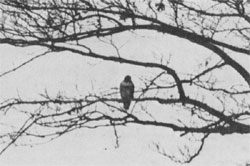First Audubon Bird Count Here
Forty-four observers put in 86 hours of volunteer bird-watching last December 19 in a 15-mile circular territory surrounding Fermilab, carrying out the "Fermilab count." The Fermilab site became, for the first time, the geographical center for the local "Christmas Bird Count," part of the National Audubon Society's 77th annual event, which takes place nationally at this time each year. The U.S. Fish and Wildlife Service is also a sponsor and the Fermilab count was directed by Richard Hoger of the DuPage Audubon Society which is responsible locally for carrying out the mission.
The observers were assigned to eight different sections in the Fermilab count circle. (See the map below.) They were grouped in twelve parties with four more people observing at stationary feeders in the area. They covered 51 party-miles on foot and 340 in cars. This was one of 13 census areas in the Chicago region where the counting took place on this date. Nationally last year, 28,000 persons took part in the Christmas count, making it the largest outdoor sport in the world.
The compiled report of activities observed in the Christmas bird count fills 650 two-column pages. The data become the information needed to plot the winter range of North American birds and, in longer perspective, changes in bird ranges and numbers. Bird populations are good indications of environmental quality. They are mobile and quick to adapt to threatening conditions.
The official count day began at 7 a.m. and ended with a gathering for tabulation in the Fermilab Central Laboratory at 4:30 p.m. The bird-watchers begin from a central point in their assigned area, then spread out in all directions, sometimes spotting from cars with binoculars, other times on foot in areas known to be strong habitats.
The 60 species garnered in the Fermilab area included two Canvasback ducks spotted in the Main Ring at 7:30 a.m. The Canvasbacks are usually seen in Lake Michigan. At the other end of the day three Short-eared Owls were seen at 4 p.m., also at Fermilab. A Budgerigar, or Parakeet, reported in Area III for the past 2 1/2 months was among the most unusual sightings. The birders conjectured that it was a runaway from a private home that had learned to cope because regular feed was available. The Pied-billed Grebe in Area VI, the Rufous-sided Towhees at feeders in Area VI and VII are considered unusual birds at this time of the year, according to Hoger. There were 8,177 individual birds sighted in the Fermilab count.
There were a substantial number of raptors -- hawks and owls -- on the Fermilab count. Large numbers were also recorded for Mallard duck, Red-winged Blackbird, Dark-eyed (Slate-colored) Junco, Tree Sparrow, Cardinal, Black-capped Chickadee, Blue Jay, and American Goldfinch.
Dick Hoger has many friends at Fermilab through his job at the Argonne National Laboratory. Many others know Dick and his wife from their Willowbrook Bird Haven in Glen Ellyn where they care for hundreds of sick and injured birds and small animals which people bring to them. Some of these are released in the Fermilab Main Ring so that they can return to their natural habitat in relative safety after they have recuperated.
Click here to see the map of the bird count area, December 19, 1976.
|
||||||||||||||||||||||||||||||||||||||||||||||||||||||||||||||||||||||||||||||||||||||||||||||||||||||||||||






